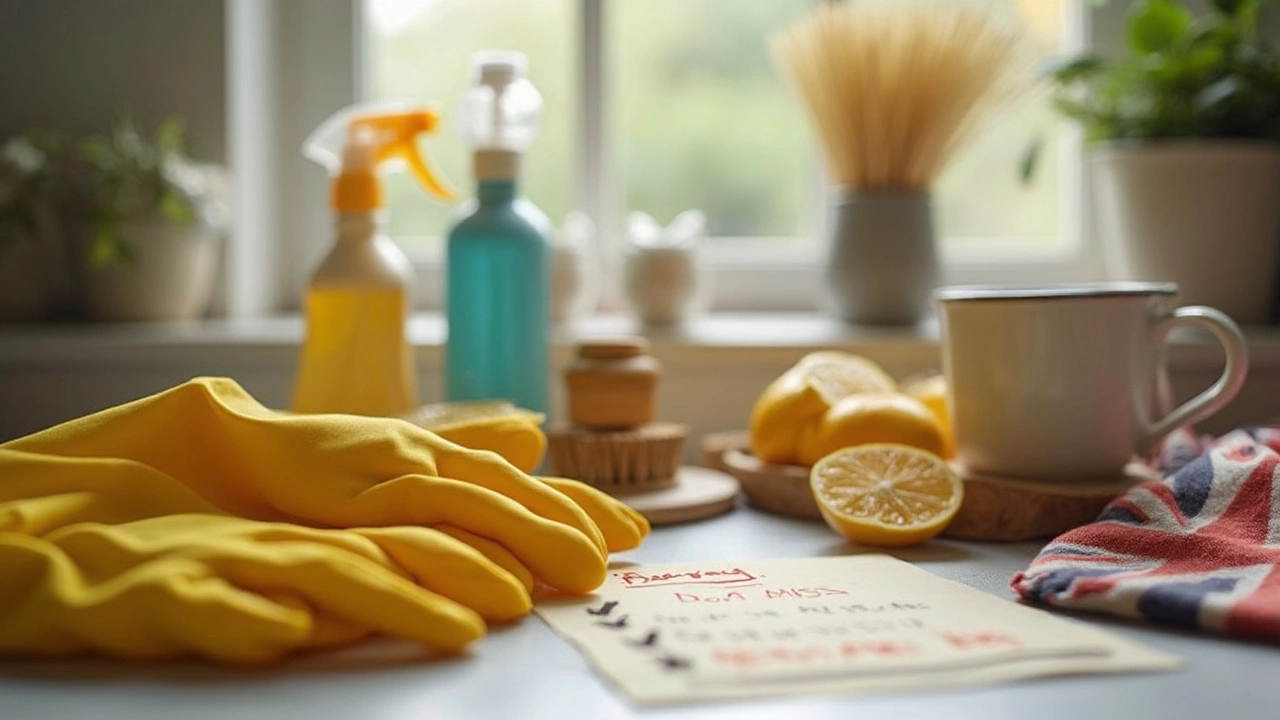If you’ve ever stepped back after a kitchen clean and wondered, “Wait, did I actually deep clean or just wipe the counters?” you’re not alone. A real deep clean takes more than a quick spray and swipe. We’re talking clearing out the fridge, scrubbing behind appliances, and getting those spots you pretend you don’t see.
So, how long does it usually take? It depends on how messy things are to start with, the size of your kitchen, and who’s helping. On average, most people spend about 3 to 5 hours for a top-to-bottom kitchen deep clean. Got a super tiny kitchen? You might knock it out in under two. If you’re dealing with a full-blown disaster zone—hello, sticky cabinet tops and forgotten leftovers—expect it to take most of your day.
The wild thing? Most folks spend twice as much time decluttering and emptying out stuff as they do actual scrubbing. Want an easy win? Clear the counters first; you’ll feel like you’re already halfway done. And don’t even think about skipping cabinet cleaning, because the grime in those corners will come back to haunt you.
- What Counts as a Deep Clean?
- Average Time Breakdown for Each Area
- Why Does It Sometimes Take Longer?
- How to Speed Things Up Without Cutting Corners
- What People Forget When Deep Cleaning
What Counts as a Deep Clean?
So, what exactly makes a kitchen deep clean, well, deep? It’s a lot more than just clearing dishes and wiping down counters. A deep clean means moving things out, tackling grime you usually ignore, and giving every surface a fresh start. It goes way past your usual weekly wipe-downs.
Here’s what a proper deep clean kitchen involves:
- Clearing out everything: Empty all cabinets, the pantry, and the fridge. Toss expired food and wipe shelves before putting anything back.
- Appliances get attention: Clean the inside of your microwave, oven, and fridge (and don’t forget the dishwasher filter). Pull smaller appliances from the countertop and scrub under them.
- Scrub every surface: This means countertops, cabinet doors (and handles), backsplashes, sink, and especially those greasy spots above the stove.
- Floor cleaning: Move chairs, bins, and small tables. Sweep, mop, and pay attention to edges—crumbs love to hide under cabinets.
- Hidden places: Get under the sink, behind large appliances if you can move them, and under the fridge. These spots are always sneakier than you expect.
- Trash zones: Disinfect areas around the trash can, and wash the bin itself if it’s washable. Old spills and food leaks basically set up camp down there.
A deep clean also means swapping out old sponges and cleaning cloths. No point smearing bacteria back onto freshly cleaned surfaces. Some folks add wiping light switches, door handles, and even vent covers to the list, and honestly, it’s worth it if you want a true reset.
Average Time Breakdown for Each Area
You might be wondering where those 3 to 5 hours actually go when doing a deep clean in the kitchen. Breaking it down by zone makes it clearer and helps keep you on track. Here’s what you should expect for each main area:
- Fridge and Freezer (45–60 minutes): Take out every shelf and drawer, toss expired stuff, and scrub every surface. Even if you’re neat, sticky spills hide in corners. Defrost your freezer if it’s come to that, but only do this a couple times a year unless things get wild.
- Oven and Stovetop (30–45 minutes): This one’s a beast if you cook a lot. Remove racks, soak them, attack burnt-on gunk with a scraper, and get into those tricky spots behind burner knobs.
- Sinks and Countertops (20–30 minutes): Scrub the sink with a good brush and get under faucet edges where grime builds up. Wipe down every inch of countertop and clean backsplash tiles if you have them.
- Cabinets and Drawers (30–45 minutes): Take everything out, wipe inside (people always miss the handles!), and re-line shelves if needed. If you rush here, crumbs and forgotten spills hang around forever.
- Floors and Trash (15–30 minutes): Sweep, then mop. Pull out your trash can and clean beneath it; it’s almost always gross under there.
Of course, these are average times, not some official rulebook. If you have a big kitchen or it's been months since your last deep clean kitchen session, expect things to go slower. If you tackle things more regularly, you'll save time each round.
A quick tip: set a timer for each section. It sounds silly, but it keeps you moving and stops you from spending twenty minutes arguing on the phone while scrubbing your fridge.

Why Does It Sometimes Take Longer?
Ever walked into your kitchen all set to deep clean kitchen and ended up spending twice as long as you planned? You’re not alone. Several little things add up and stretch out the whole process.
One big reason is clutter. It’s easy to forget how much stuff ends up on counters, in drawers, and behind appliances. Sorting through expired food, junk mail, or those mystery Tupperware lids eats up way more time than scrubbing a counter ever will.
Another time-eater is built-up grime. Grease from cooking, spills you ignored last week, and sticky fingerprints can turn a regular wipe-down into a full-on scrubbing session. Older kitchens or homes with kids and pets tend to take longer to clean because, let’s face it, messes multiply fast.
- Appliance deep cleans: Think oven racks, fridge shelves, and that gunk in the microwave. If you haven’t done it in months, it might take an hour just for one big appliance.
- Detailed work: Things like cleaning grout, door handles, light switches, and backsplash tiles get ignored with quick cleans, but they grab your attention during a deep clean.
- Repairs or maintenance: Sometimes you find a leaky pipe, a sticky drawer, or a loose handle that you just have to fix before the real cleaning can happen.
Distractions are another sneaky culprit. If you’re always stopping to check your phone, answer the door, or tend to kids (or pets!), your total time can jump quite a bit.
Here’s a quick look at what slows most people down, according to a 2024 home cleaning survey:
| Cause | Extra Time Added (average) |
|---|---|
| Tackling clutter | +45 minutes |
| Baked-on grime (oven/stove) | +40 minutes |
| Forgotten spots (tops of cabinets, vents) | +30 minutes |
| Unexpected repairs | +20 minutes |
| Distractions (family interruptions) | +25 minutes |
So, if deep cleaning your kitchen feels like it drags on forever, it usually comes down to clutter, tough messes, fixes you weren't expecting, and life just happening around you. Knowing these traps ahead of time can help you plan and cut down the time when you tackle your next big clean.
How to Speed Things Up Without Cutting Corners
You want a spotless kitchen, but nobody wants to be cleaning all day. Good news: most people waste more time hunting for supplies and switching tasks than actually scrubbing. If you plan the right way and stick to the basics, you’ll shave off major time without losing quality.
- Deep clean kitchen kits are a time-saver. Bundle up your go-to cleaners, scrub brush, microfiber cloths, and rubber gloves in a caddy. Keep it all in arm’s reach and skip the back-and-forth to different cabinets.
- Start high and move low. Knocking crumbs or dust down onto places you haven’t already cleaned saves double work. Get the tops of fridge, cabinets, and shelves handled before you move to counters and floors.
- Set a timer for each job. Challenge yourself, but don’t rush. If you give yourself 15 minutes for the stove, you’re more likely to make progress instead of picking at tiny details too soon.
- Let cleaners do the heavy lifting. Spray tough spots (like the stove top or baked-on grease) and step away for 10 minutes. Come back when the grime is soft, and the job takes half the elbow grease.
- Go appliance by appliance rather than bouncing around. Doing all the small appliances in one batch, then moving to the fridge, and so on, means you get into a better cleaning rhythm.
Here’s a quick look at how people who time themselves actually stack up:
| Task | Average Time (Minutes) | With Smart Steps (Minutes) |
|---|---|---|
| Clearing counters | 20 | 12 |
| Fridge clean-out | 30 | 18 |
| Oven & stove scrub | 25 | 15 |
| Cabinet doors | 18 | 10 |
| Floors | 15 | 8 |
See that? Planning basics can save nearly 40% of your time. Another real hack: stick on headphones, cue up your favorite playlist, and just flow from one thing to the next. Fewer distractions, more progress. And if you split up jobs with a partner or family—like Isla and I sometimes do—the whole thing flies by. Remember, fast doesn’t mean sloppy, just smarter.

What People Forget When Deep Cleaning
Ever finished a deep clean kitchen session and felt like something still smells weird? Turns out, most people leave a few key spots behind—spots that quietly build up grime no matter how often you wipe the counters.
The number one spot everyone skips? The range hood filter. Grease gets sucked up there every time you fry, and if you’ve never popped it out, it’s probably gross. Just stick the filter in hot, soapy water with a little baking soda. Another biggie: the space behind and under your fridge or stove. Crumbs and random debris love to hide there, and if you have pets, watch out for hairball city.
Here are more spots almost everyone misses:
- Light switches and cabinet handles: Germs hang out here way more than you'd think. A 2023 study found they had the highest bacteria count out of any spot in most family kitchens.
- Dishwasher rubber seals: They trap everything from food bits to mold. Wipe with vinegar or a toothbrush.
- Sink drains and garbage disposal: Deodorize with baking soda, then rinse with boiling water. That funky kitchen smell? Usually coming from here.
- Small appliances: Toasters, blenders, coffee makers always have hidden crumbs or leaks. Pull out all removable parts and wash them.
This table breaks down how often the most-forgotten areas actually get cleaned, according to a 2024 home habits survey:
| Kitchen Spot | Most People Clean | Should Clean |
|---|---|---|
| Range Hood Filters | Every 6 months | Monthly |
| Light Switches & Handles | Every 3 months | Weekly |
| Dishwasher Seals | Once a year | Monthly |
| Sink Drains | When clogged | Monthly |
| Small Appliances | Only when dirty | Every deep clean |
Bottom line: If you want that just-cleaned feeling to actually last, it pays to target the sneaky areas people always forget. Next time you deep clean, hit these spots, and your nose (and your guests) will thank you.
